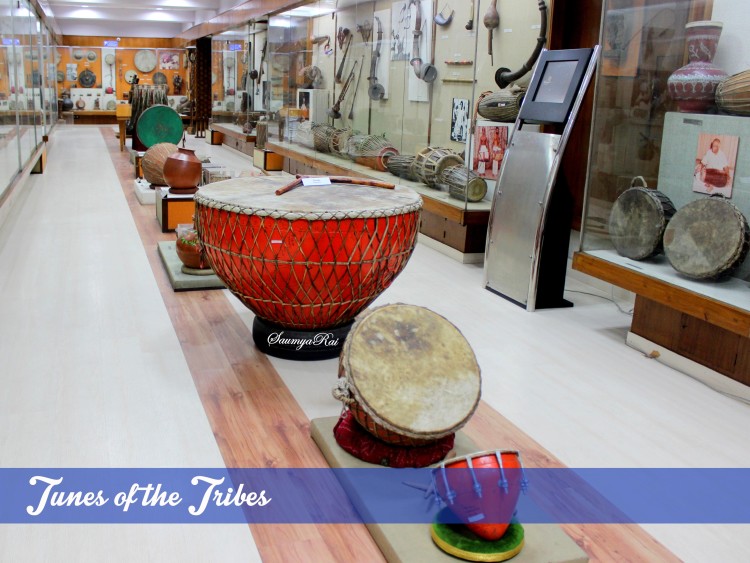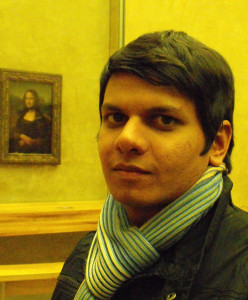While many of us can easily classify sounds of western musical instruments that are available in stores, can we also identify the sounds of our tribal musical instruments? Such instruments are not found in any store. There are hundreds of such instruments used by communities all across India, and they are made by the artist itself by using materials like coconut shell, pots, animal skin and bamboo. Their music can never be studied in isolation from the social and ritual practices of indigenous people. Their music is never an exclusive property of the singer, but is owned by the entire community. There are also no finishing schools to study such music. Tunes of the tribes are passed on from one generation to the next.
I visited the Gallery of Musical Instruments by Sangeet Natak Academy where I saw instruments that my textbooks never taught me about. I couldn’t have written about the entire collection, but here is a glimpse of what I saw along with short stories on these instruments.
|
1. Chikara: It is a bow and string musical instrument from Bengal made of two strings of horse hair and one string of steel. It is extensively used by the tribes of Rajasthan, Madhya Pradesh and Uttar Pradesh. It is played by sliding fingers over strings rather than pressing the strings. Traditionally, Chikara was used extensively by the ‘Pradhan’ community consisting of chiefs and people of ministerial positions. Pradhan, the high caste family name was partially over ruled by Persian names like ‘Wazir’ and ‘Diwan’ during Mughal era.
—
2. Sarinda: It is a stringed instrument with three to thirty strings depending on the region it is played in. Sarinda could also be a derivative of Qobuz, an instrument from Central Asia. It is played by the Baul community of Bengal and Bangladesh.
There are various misconceptions about being Baul. They are described as possessed or crazy mystics. However, being Baul is an ocean of devotion towards Indian philosophy, Yoga, Tantric, Vedic, Puranic and Upanishad wisdom. The title ‘Baul’ implies that one is a Guru, Pandit, or Acharya who were the source of knowledge before books. They are oral storytellers, spiritual bards, masters of Nada Yoga and Vayu Dharma.
‘Baul Fakir Utsav’, is a show that is organized in Kolkata where Bauls from several districts of Bengal and Bangladesh come to perform in a continuous 48-hour musical performance.
—
3. Ghumat: It is also known as ‘Ghumot’ and is an earthen pot open from both sides. The bigger opening is covered by skin of monitor lizard. It is a part of Goan folk music (both Hindu and Christian), and is played during Ganesh festival. It is used in Mando music of Goan Catholics. The major theme of Mando is love, where men wear coats showing Portuguese influence, and women wear bazu-torop and pano-baju of red, blue or green silk. The themes and emotions of Mando vary from jilted lover crying, young lovers making sweet promises, and lovers parting.
—
4. Pepa: It is made by tying two horns of a bull together and is played in Bihu festival of Assam. Pepa is played by a young male Bihu artist called ‘Bihuwas‘ whle the rest accompany him clapping their hands and playing ‘Dhol’ with lesser intensity.
The ‘Mishing tribe’ call it Pempa and plays it in various dances like Gumrak Sohman and Lotta Sohman of Ali Aye Leegang festival. Ali means ‘roots and shoots’, Aye means ‘fruit’ and Leegang means ‘beginning’, thus making it a festival of beginning of sowing seeds. The village elders sow rice paddy in the corner of their rice field, whereas the young men and women sing and dance all night over music of Drums, Cymbals, Pempa and Gong.
Conflict with humans, reduction in forested land and their conversion into farm lands has gradually reduced population of bulls, therefore it has increasingly become difficult to find Pepa now.
—
5. Pena: It is a traditional mono-string musical instrument of Meitei community of Manipur. Pena was originally played in the houses of rich, but slowly it became part of the folk culture and then of festival performances. It is played in Meitei folk music in Lai Haraoba festival, which is celebrated by recollection of stories played by deities during the origin of universe, animals and plants.
Pena is not just an instrument for entertainment, it signifies creation and evolution. A Pena artist is a healer of ailments. The Meitei kings used to accompany a Pena artist while heading for voyages.
It slowly became a dying art until efforts were made by Center for Research on Traditional and Indigenous art which holds regular workshops for youth.
—
6. Kangling: It is a trumpet made out of human femur bone, and is used in Tibetan Buddhism for chöd rituals. Usually, the bone of a person who died a violent death or that of a respected teacher is used. The Kangling should only be used in chöd rituals performed outdoors with damaru and bells.
In Tibetan Buddhism, chöd means to sever the illusion that we are merely physical beings. By loosening the bonds we have with our physical bodies, we are liberated from fear – which is the ultimate obstacle to spiritual realization. In practicing chöd, we learn to dance and be joyful in the midst of chaos, horror or death – whether literal death, or simply the death of hopes. Chöd is a celebration of generosity and of your connection to people and other creatures in the web of life and death.
—
7. Dotora: It is another instrument commonly associated with the Baul community of Bengal. Music of Dotora is very close to that of Rabab. It is extensively used by traditional singers in Bengal, Bihar, Bangladesh, and Goalpara and Kamroop districts of Assam.
—
8. Chempreng: It is a hollowed out single piece of wood with its neck covered by thin fibrous layer of betel nut plant. Chempreng is an indigenous musical instrument of Tripuri people. Along with weddings and religious ceremonies, it is played in festivals like Kharchi Puja, Ker festival and Garia Puja. Kharchi Puja is done to worship ‘khya’ or the earth. It is performed to wash out the sins and to clean the post menstrual phase of mother earth’s menstruation. Garia Puja is done on the seventh day of April to celebrate the harvest. People from all communities seek blessings from Lord Garia, symbolized by a bamboo pole and worshiped with flowers and garlands. This is followed by performance of Garia dance.
—
9. Gopi Yantra: It is used by the Baul community of Odisha and neighboring states. Gopi Yantra is a Baul’s symbol for peace and unity for all. The split bamboo is manipulated to produce variations in tone. It is made of dried pumpkin, wood or coconut to which a split bamboo cane is attached as a neck.
—
10. Ladakh Damaru: It is made of human skull with skin covered faces. A coloured cloth, silk strips tied around the drum waist. Also attached are two knotted cords to strike the heads. It is used by Lamas in Chham ritualistic dance. Chham performers often wear elaborate masks ranging from fearsome and grotesque to pleasing ones. Chhams are not for amusement rather spiritual dances, invoking blessing in order to ward off evil. The music is slow and haunting, and dancers move around very slowly with main focus being the masks, not the dance itself.
—
11. Devalai Sangu: It is a conch shell with funnel shaped mouth piece of brass, fitted on the blowing end. An elaborate decorative piece of brass is attached on the other end by wax. It is used in ‘Panchavadya’ ensemble in temples of Tamil Nadu and Kerala.
|
|
Visit the Gallery of Musical Instruments: Musical Instruments Museum | 35, Ferozshah Road | New Delhi – 110 001 | Ph: 011 23387246/48 | Email: mail@sangeetnatak.gov.in | Website: www.sangeetnatak.gov.in
Travel with me on Facebook, Twitter & Instagram
Feature image: Saumya Rai
Illustration: Bhargavi Madhiraju
Related Articles –
Chhattisgarh – Tribes, Ancient Civilizations, Eroticism and Responsible Travel
Responsible Travel & Social, Financial and Environmental issues of Rural India
Unseen countryside of Northern Thailand
Gaurav BhatnagarSoftware Engineer turned Travel Writer, Photographer, and Public Speaker on Responsible Travel. Entrepreneur in Responsible Rural Travel @ www.thefolktales.com
|










We are more curious to visit this place after reading this well written comprehensive post. Instruments do reveal lot about culture and this gallery is now must visit place for us.
Thanks guys. Appreciate it. Do visit this place and let us know about your experience. 🙂